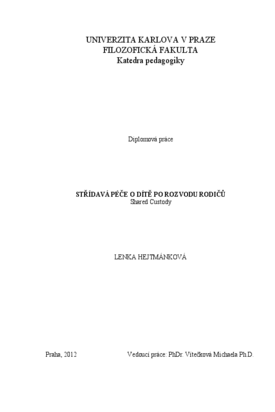Střídavá péče o dítě po rozvodu rodičů
Shared Custody
diplomová práce (OBHÁJENO)

Zobrazit/
Trvalý odkaz
http://hdl.handle.net/20.500.11956/44716Identifikátory
SIS: 96579
Kolekce
- Kvalifikační práce [23420]
Autor
Vedoucí práce
Oponent práce
Tvrzová, Ivana
Fakulta / součást
Filozofická fakulta
Obor
Sociální pedagogika
Katedra / ústav / klinika
Katedra pedagogiky
Datum obhajoby
29. 5. 2012
Nakladatel
Univerzita Karlova, Filozofická fakultaJazyk
Čeština
Známka
Velmi dobře
Klíčová slova (česky)
Rodina, rodinné právo, potřeby dítěte, rozvod, komunikace, střídavá péče, rodinná mediace, kolizní opatrovníkKlíčová slova (anglicky)
Family, family law, child needs, divorce, communication, shared custody, family mediation, conflict curatorDiplomová práce má povahu teoretické studie. Charakterizuje střídavou péči o děti po rozvodu rodičů jako nejvhodnější porozvodové uspořádání. Tento předpoklad vychází z vývojových změn evropské rodiny od dob francouzské revoluce, vývoje rodinného práva a důležitých aspektů rodinného práva, dále z potřeb dítěte, definice mateřské a otcovské lásky. Tuto hypotézu podporují i výsledky zahraničního výzkumu, které porovnávají život dětí v různém porozvodovém uspořádání. Následně práce pojednává o mediaci jako o vhodné možnosti pomoci rodičům dospět k takovému řešení, které bude vyhovovat všem zúčastněným stranám sporu. Na závěr jsou uvedeny případové studie.
This thesis is a theoretical study that characterizes shared childcare after divorce as the most suitable post-divorce arrangement. This assumption is based on developmental changes in the European family from the time of the French Revolution, the development of family law and important aspects of family law, as well as on the needs of children, and definitions of maternal and paternal love. This hypothesis is also supported by the results of foreign research, which compares the lives of children in different post-divorce arrangements. The following paper discusses mediation as an appropriate way of helping parents achieve a solution that is suitable for all participants in the dispute. In the conclusion some case studies are presented.
